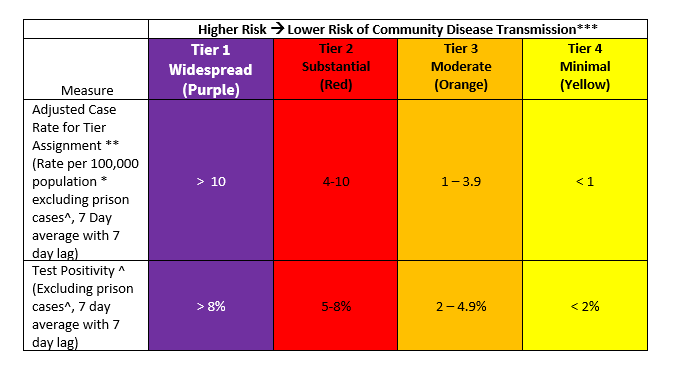Background
Given the progress of COVID-19 vaccination among healthcare personnel, CDPH recommends a cautious and gradual lifting of certain restrictions while remaining vigilant for breakthrough infections and transmission in facilities through ongoing surveillance and testing. CDPH recognizes the importance that visitors play in the mental well-being and recovery of patients; therefore, CDPH is revising the visitation guidance for facilities, effective on March 23rd (one week from the release of this AFL), to encourage safely getting more visitors to the bedside and updating prior recommendations for visitation.
For health facilities located in counties with substantial or lower risk levels of community transmission (as per CDPH's Blueprint for a Safer Economy website, any county not in the purple tier), CDPH recommends that hospitals allow two visitors from the same household at the same time, at a time (provided social distancing can be accomplished) and visitors comply with hospital visitor guidelines.
For purposes of this AFL, the terms "visitor" and "support person" are used interchangeably, as are "patient" and "resident."

Visitors do not need to be designated in advance by the patient; however, each visitor is subject to screening for fever and COVID-19 symptoms and must wear a face covering upon entry and at all times within the facility, and other personal protective equipment (PPE) as appropriate while in the patient's room. Facilities should also limit visitor movement in the facility. For example, visitors should not walk around in hallways of the facility and must go directly to and from the patient's room.
In addition, CDPH has developed visitor guidelines for specific patient groups to ensure support for their mental health and well-being, while striving to limit the spread of the virus. The following expanded visitation guidelines are recommended by CDPH for specific populations regardless of the county positivity rate.
Pediatric Patients
- Visitors are essential for the mental health of pediatric patients. CDPH recommends that pediatric patients be allowed up to two support persons at a time.
- In the case of prolonged hospitalization, the facility should permit two designated support persons for pediatric patients.
- For NICU and PICU patients, the facility should permit two designated support persons that may visit at the same time.
Labor and Delivery Patients
- The presence of a partner or support person is essential to the mental health of patients who are in labor and delivery. CDPH recommends that up to two support persons be allowed to be present with the patient. In addition to the support person(s), CDPH recommends that a doula, if desired by the patient, be permitted to be present if prior arrangements have been made with the hospital and the doula complies with hospital PPE and infection control guidelines.
Surgery PatientsThe presence of a visitor is essential to the well-being of surgery patients (both inpatient and outpatient). CDPH recommends that up to two visitors be permitted until the patient is taken into prep (provided social distancing can be accomplished), and up to two visitors when the patient is in recovery and preparing for discharge.
Patients at End-of-Life
- Visitors are essential to the mental health of patients who are at end-of-life. For their continued mental health, and well-being, CDPH recommends that up to two visitors be allowed to be present with the patient; a single visitor does not need to be designated.
Patients with Physical, Intellectual, and/or Developmental Disabilities and Patients Cognitive Impairments
- The presence of a support person is essential to patients with physical, intellectual, and/or developmental disabilities and patients with cognitive impairments. CDPH recommends that up to two support persons be allowed to be present with the patient.
- For patients, especially with prolonged hospitalization, the patient or family/patient representative may designate two support persons.
Students Obtaining Clinical Experience
- CDPH supports efforts to ensure that new nurses and other professionals coming into the healthcare workforce are able to obtain necessary clinical experience. CDPH encourages students obtaining their clinical experience be permitted to enter the facility if they meet the CDC guidelines for healthcare workers to maintain the workforce needed during this pandemic.
Hospitals may allow volunteers in the facility in compliance with their internal policies.
All visitors and support persons must stay in the patient's room. Visitors and support persons should be screened by the facility upon entry for fever and COVID-19 symptoms, and be asymptomatic for COVID-19 and not be a suspected or recently confirmed case. Visitors and support persons must wear a face covering upon entry and at all times within the facility, and must comply with any health facility instructions on PPE while in the patient's room. Visitors should maintain physical distancing from other visitors not from the same household as well as from the facility HCP at all times.
Additionally, CDPH strongly encourages facilities, including but not limited to skilled nursing facilities, to create ways for residents and patients to have frequent video and phone call visits. If shared devices are used for video calls facilities should ensure appropriate infection control measures are in place. For additional visitation guidance applicable to skilled nursing facilities, please see AFL 20-22.6.
If you have any questions about this AFL, please contact your local district office.
Sincerely,
Original signed by Heidi W. Steinecker
Heidi W. Steinecker
Deputy Director
Resources